The British and German Fleets spent the first part of World War I staring at each other across the North Sea before finally clashing in May of 1916. The initial battlecruiser encounter didn't go brilliantly for the British, with three ships suffering magazine explosions, but they managed to trap the Germans perfectly when the two main fleets met. The Germans tried to break past, but the British were between them and their bases, and held the line. They were saved from complete defeat only by nightfall, which let them sneak past and reach safety, despite a series of chaotic night actions. After the battle, the Germans never came out again in a big way, but controversy raged in Britain over who had won and why the victory hadn't been more complete.
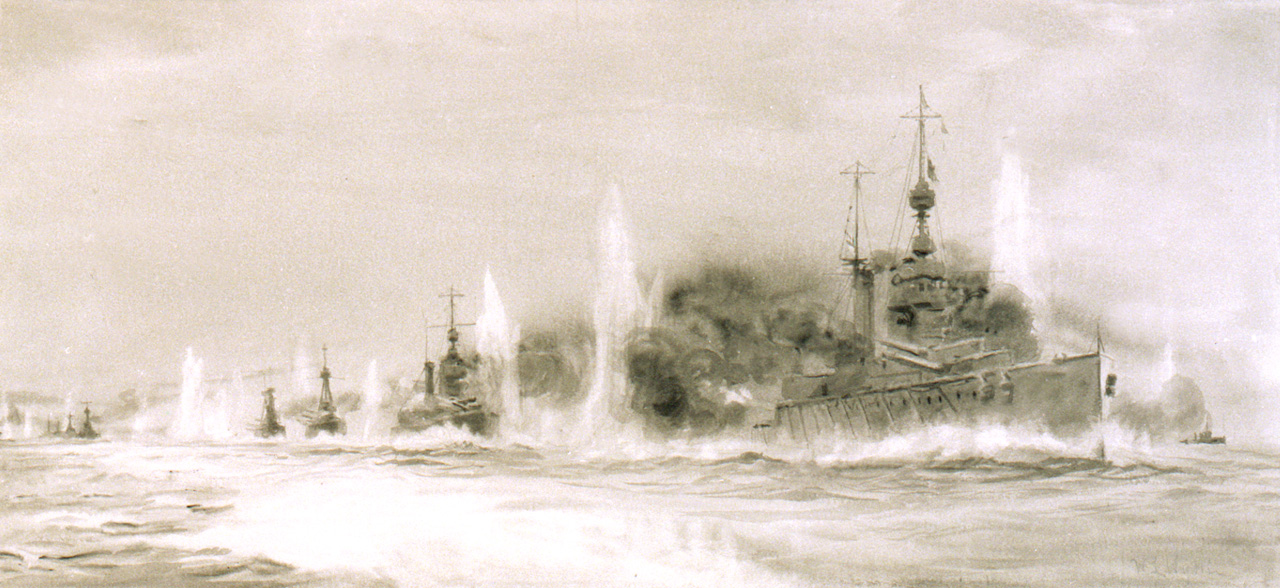
Jutland: Alternate History
This brings us to the what-ifs of the battle. What could either side have done better? Could Jellicoe have won a victory on the scale of Trafalgar? If so, what would have happened? Could Scheer have managed to do enough damage to the British fleet to break the blockade?
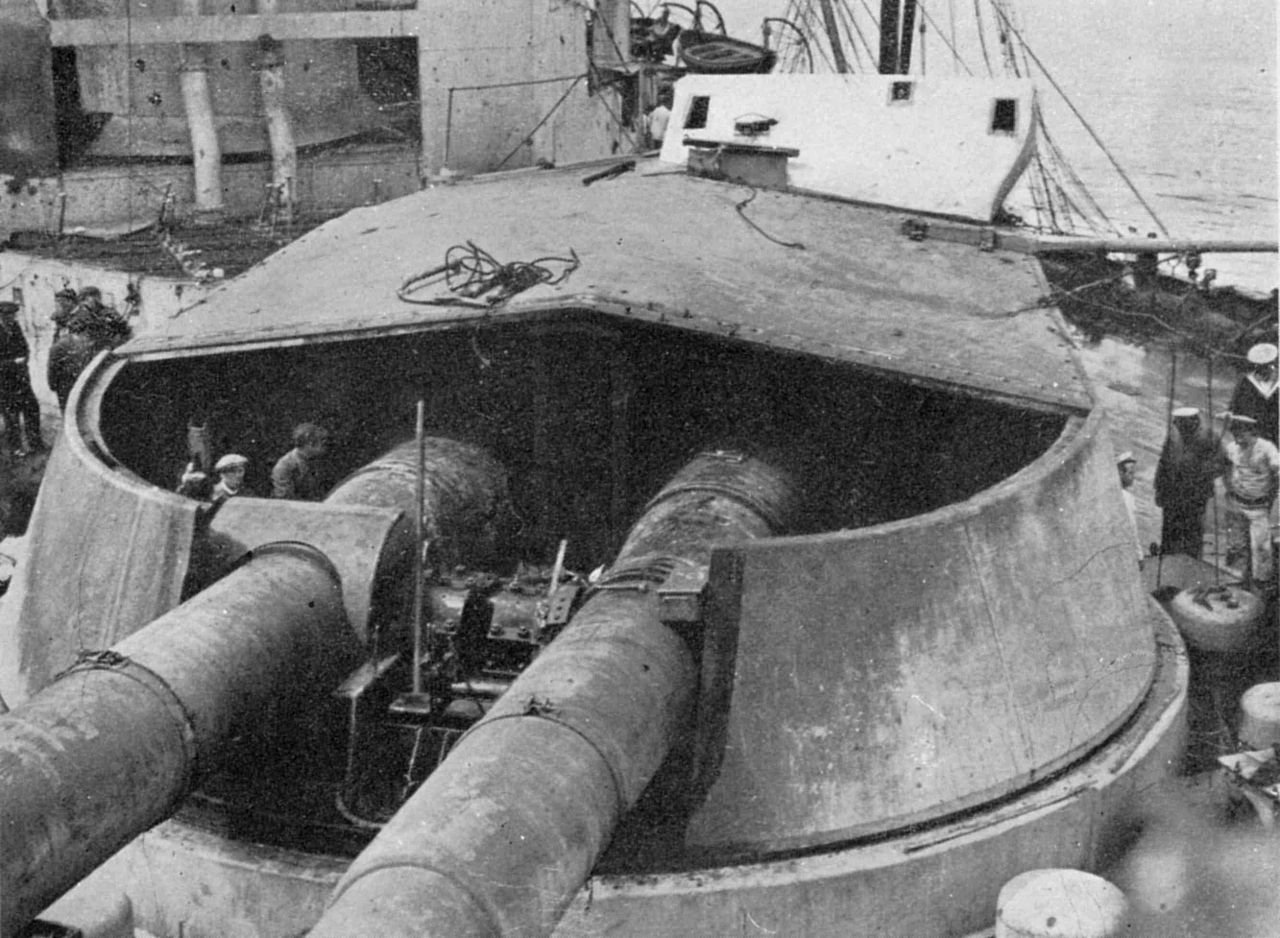
Damage to Q Turret of Lion
The daylight battle looks strangely resistant to what-ifs. The broad strokes of the runs south and north would not have been badly affected if Indefatigable and Queen Mary had not blown up, or if Beatty had handled the 5th BS better. Despite all of Beatty’s mistakes, he did lead Scheer to Jellicoe as planned, and Jellicoe made the right decision when it came to the deployment. It's a massive credit to Jellicoe that fixing any problems doesn’t really make the British position that much better when the deployment starts. Scheer also fought skillfully and well, and to get a significant difference in the outcome of this phase, we have to introduce major mistakes on one of the flag bridges. A change of mind on Jellicoe’s part during the turn-away is likely to have lead to losses among the Grand Fleet. In all probability, these losses would not be enough to change the balance of power in the North Sea, although a particularly bad day might have seen relative parity between the combatants.
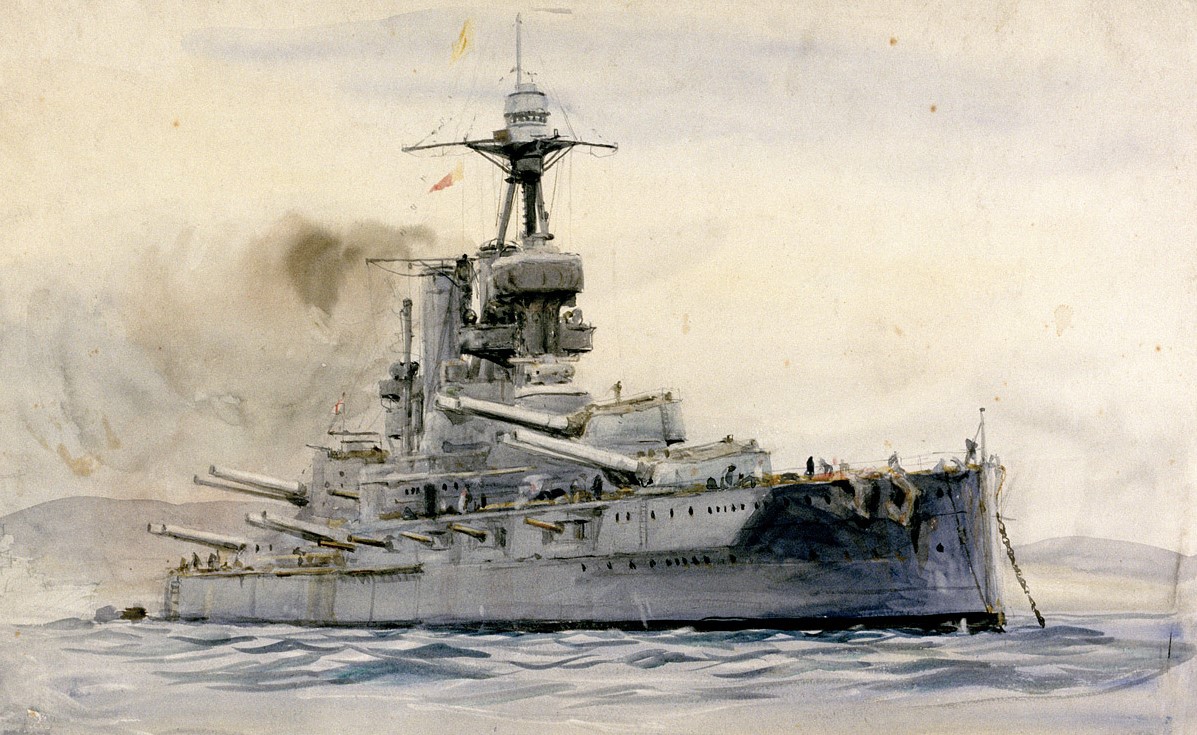
Iron Duke at anchor1
The night action is a different story. Here, the British screwed up by the numbers, and I’d discard the real history as a particularly stupid what-if by German fanboys if I was in an alternate universe. There are lots of factors here. British feelings of inferiority in night-fighting, lack of initiative among the fleet, miscommunications and general lack of communication, and Jellicoe’s distrust of Room 40. If any of these had changed, the results might have been very different.
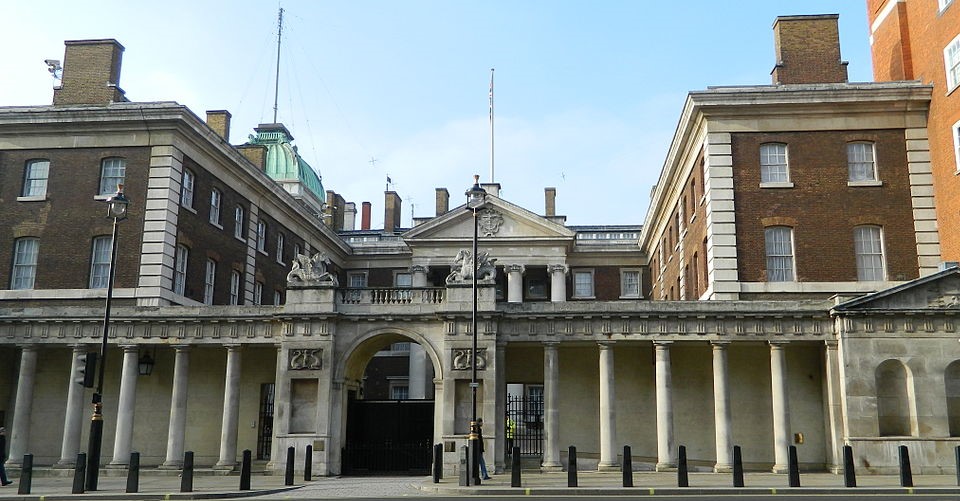
The Admiralty Building of 1790, where Room 40 was located
A night action between the capital ships would have been very risky for both sides. Even I haven’t been able to figure out exactly who was where and doing what at a given time, so it’s really hard to give concrete predictions as to the results of a given ship choosing to open fire. Night gunnery did not become feasible except at short range until radar arrived, so it’s possible that several small actions between capital ships could have been fought without it turning into a general engagement. The destruction of Black Prince is the prototype for this, and Moltke and Seydlitz probably should have been destroyed by the British.
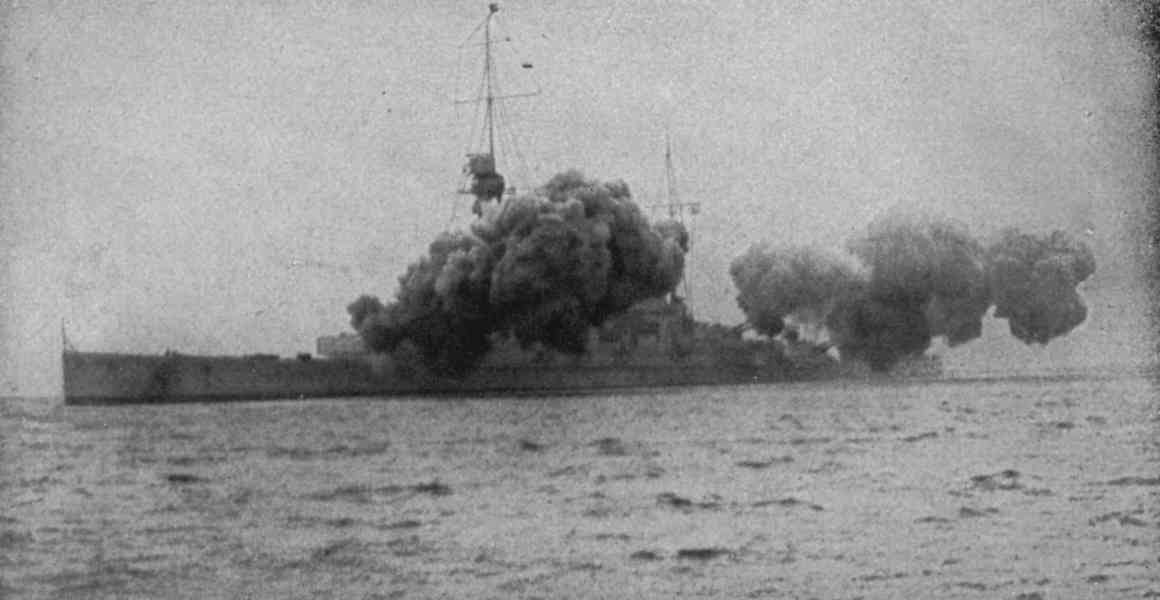
Derfflinger firing a full broadside
But what if Jellicoe had gotten enough information to figure out that Scheer was making for Horns Reef, and had intercepted him there at dawn? This requires somewhat more competence on the part of the chain between Room 40 and Jellicoe, but not enough to strain plausibility, particularly if Room 40 and the Admiralty had communicated better early on the 31st. As dawn breaks, the Grand Fleet opens fire at the Germans starting down the channel to the Jade. They have good gunnery conditions2 and almost certainly sink at least Seydlitz, who was in real trouble at that point. The obvious wildcard is the weather, but it’s not impossible to imagine the High Seas Fleet pinned against the Danish coast unable to return effective fire and badly damaged if not destroyed.
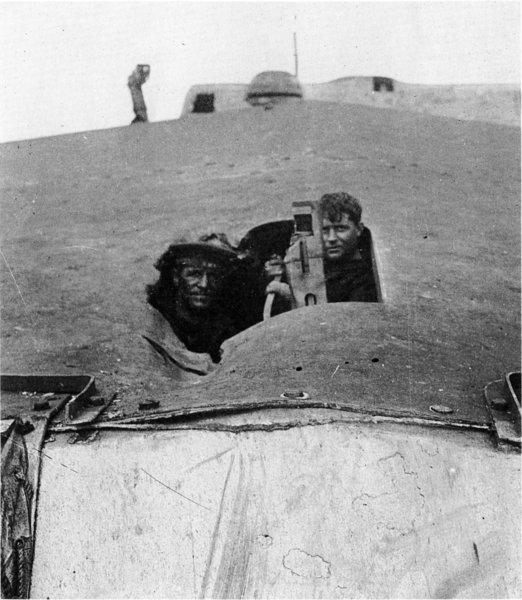
A hole in the roof of Tiger's X Turret
In that case, there might have been huge repercussions. With a battle fleet now unchallenged, the British might have been able to enter the Baltic. This had been a long-time project of Jackie Fisher’s, although he had resigned. His plan to land troops on the Baltic coast of Germany was always a bit of a long-shot, and was very unlikely after the failure of Gallipoli. However, the real prize in the Baltic would be the ability of the British to reach St. Petersburg. This would have massively improved the ability of the British to support the Russians, and might well have forestalled the Russian revolution, or allowed a more effective allied intervention to suppress the Bolsheviks. The results of that are well outside the scope that I’m looking at, but are potentially massive.
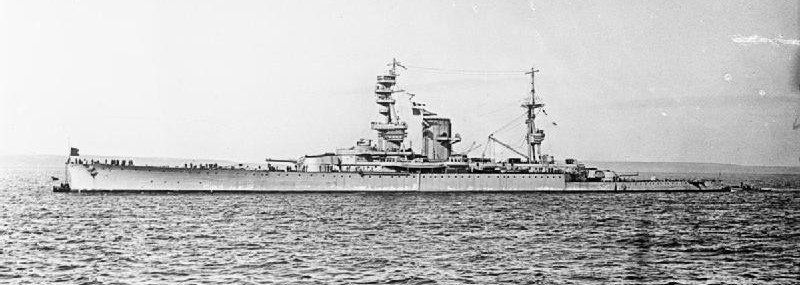
HMS Courageous, one of the ships built for Fisher's Baltic Strategy
Another benefit to the British would be in the war against the U-boats. Early in the war, the British planned to attack the island of Borkum in the North Sea off of the Jade, but this plan was abandoned due to potential German interference. With the main mechanism for said interference gone, the British might have been able to turn Borkum into a base for their campaign against the U-boats, which could now be intercepted closer to Germany, where they had less room to maneuver. Also, the High Seas Fleet provided much of the manpower for the U-boat force, and the loss of that manpower would not have helped the Germans. The British could also detach the destroyers assigned to the Grand Fleet, and use them as escorts instead.

The High Seas Fleet in Kiel
But what about a German victory? This is hard to arrange, and involves several strokes of bad luck or even more serious mistakes by the British. Even the loss of half a dozen battleships would have been survivable without a major change to the war, as the British had that many either in the yards or about to be completed. But if we ignore all of that, what is the result of a German victory that breaks the blockade?
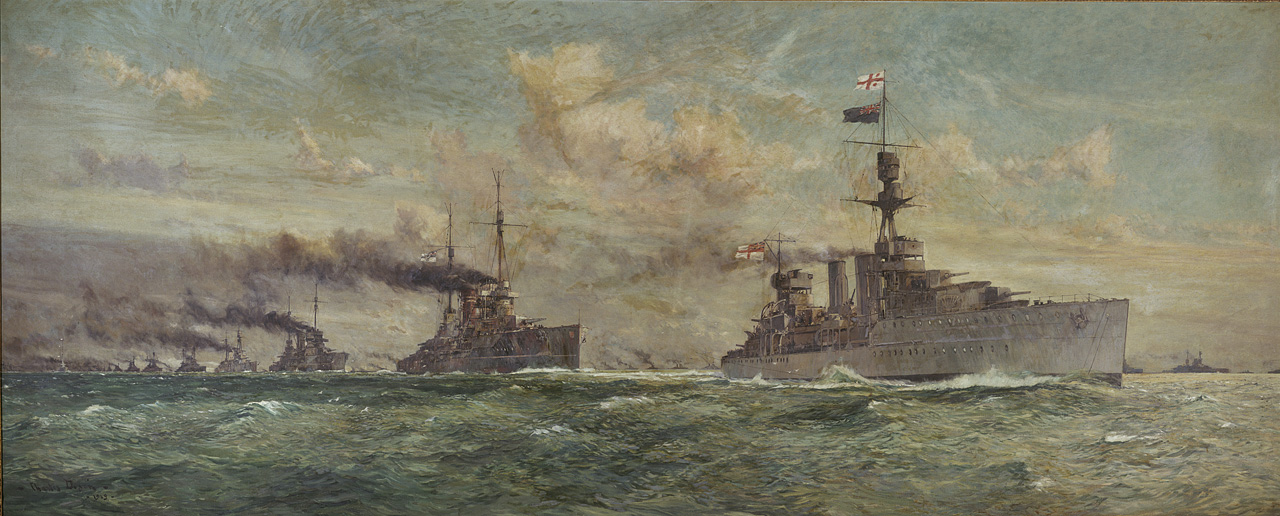
The High Seas Fleet surrendering in the Firth of Forth
This is where the US enters the picture. The US business community was not happy with the British blockade, and I’ve even seen suggestions that the 1916 fleet was intended to be capable of breaking it. If the Germans were able to resume trade with the US,3 it’s entirely possible that the US would stay isolationist, particularly because in this situation unrestricted submarine warfare would be unlikely to occur. This greatly strengthens Germany, probably avoiding the Turnip Winter, and weakens the Allies. I’m not sure where the war, or the world, would go from there.
1 This image, and all of the title images for this series, are by artist William Lionel Wyllie and most come from the collections of the Royal Museums Greenwich. ⇑
2 Geography and strategy both put the British to the west, shooting at the Germans against a the pre-dawn sky with the window closing when the sun comes over the horizon and reverses conditions. ⇑
3 This is a big if, and one that I don’t want to go into here. ⇑

Comments
So, basically the British won the naval war in the decade prior, by outbuilding the Germans? Then they used their fleet competently enough to intimidate the High Seas Fleet into mostly staying home?
That leads to another question: port defenses. Both sides believed the Brits could win any straightforward slugging match between whole fleets. Why couldn't they sail the Grand Fleet to Wilhelmshaven in August 1914 and force that slugging match?
Exactly. So long as they didn't do anything stupid or get really unlucky, they could avoid losing, and that would eventually bring victory. John Schilling said in the SSC thread that "for several centuries, the British did manage to rule the seas with essentially an unending series of draws where the enemy never quite managed to land an army on English soil or strangle England’s trade or break England’s blockade, even if it looked for a while like they might come close." WWI was in a lot of ways the last time that strategy played out.
Because a coast is a nasty place to be when you're not welcome. First, until the WWII generation of fire control systems, ships were at a major disadvantage against land-based guns, which weren't moving around. I don't know what Wilhelmshaven's guns looked like, but I'd guess they were substantial. Second, the defender can take the opportunity to stack mines and small torpedo craft around the base. Coming in close makes you really vulnerable to them. Attack at source didn't become really feasible until the aircraft carrier got good during the 30s.
What if we assume the weather doesn't prevent the Zeppelins from shadowing the British fleet, either because the weather was better on 28 May 16 or because the Germans were able to reschedule the action?
The boring answer is that the British realize they are at a disadvantage and go home. Scheer gets to sink a bunch of British freighters off the Norwegian coast, but this doesn't change history. Jellicoe looks like a coward, which maybe does change history if Beatty takes over the Grand Fleet prematurely and runs it like he did the battlecruisers.
If the British press on, they presumably lose a few battleships to coordinated submarine ambush, but not enough to change the balance of forces at Jutland. Can the Germans use aerial reconnaissance to, e.g., arrange for their battleships to cross Beatty's 'T' before he knows what is happening and while the Grand Fleet is too far back to promptly reinforce? Does that wind up even worse for the British when the Grand Fleet sails headlong into the fight rather than maneuvering for advantage?
I think you're sort of misunderstanding the original German plan. They were going to go after Sunderland, with the intent of drawing the British out and maybe defeating Beatty in detail, while the U-boats stationed off their ports took shots at the ships as they came out. The Zeppelins were there to make sure Scheer didn't get surprised and trapped by the British. The original plan would almost certainly result in something like the August sortie, which used pretty much the same model.
I'm not sure how important the lack of signals to the submarines were. Keep in mind that if not for Room 40, the British wouldn't have opposed the sortie at all, and signalling to the submarines would have been a waste.
In fairness to Beatty (which I am loathe to be) he ran the Grand Fleet pretty sensibly when he was given command.
Probably not. Keep in mind that the Germans simply didn't have plotting at this point. No concept of it. Without that, it's basically impossible to spring that sort of trap at sea. Even with the state of the art at the time, it would have been really difficult for the British to do so. And Scheer usually kept his fleet pretty close together, too.
I ran a source check, and there’s a couple of things I missed earlier. First, the U-boats were available because they weren’t doing unrestricted submarine warfare. Given that they only tried luring the fleet over submarines a couple times, and never when the U-boats were free to ravage merchant ships, I think it was seen as largely ineffective. Hunting fast ships from a WWI-era submarine is really tricky, and the Grand Fleet counts as fast in this case. Also, it was much better escorted than a typical convoy.
Second, the timing of the operation tied in with the U-boats. They were dispatched on the assumption that the fleet would sail around the 20th of May. The last day most of them could stay on station was June 1st, which is why the operation went into the Skaggerak instead of delaying more so the weather could clear.
What is plotting in this context? Locating things on a map?
Yes, but it's more than that. It's systematically attempting to construct a real-time map of the battle based on reports from other ships. I know that doesn't sound that hard, but it takes a lot of effort to get right, and the Germans hadn't even started to try. I'm writing up a post on the subject now.
The lack of formal plotting would have crippled any German attempt to make tactical use of superior reconnaissance, I agree. They could possibly have coordinated a ambush if a zeppelin observer were to issue the tactical commands to the U-boats and/or High Seas Fleet while both British and German forces were in sight from above but over the horizon to each other, but if the Germans hadn't trained for that in advance it probably wouldn't have worked in practice.
Regarding,
This applies just as well to the Danish coast, which I think is a dealbreaker for any British plans to exploit a Jutland victory by moving into the Baltic. German respect for Danish neutrality in WWI was explicitly conditional on their barring passage to British warships, and Danish navy deployed and protected extensive minefields to that end.
Granted, and that blocks the main path into the Baltic. But the Swedes refused to mine their side of the coast. The Oresund is narrow in places, but I doubt it would be impregnable there. The British also had the option of doing a methodical assault, slowly grinding away at the minefields. Minefields, like all fixed fortifications, are vulnerable to that if they aren't backed up by mobile forces. I'm still not saying it was a good plan, but I think it was at least not completely insane.
One of the things to keep in mind is that Zeppelins proved to be lousy at reconnaissance, partly for lack of practice and partly because of navigation issues. Reported Zeppelin positions could be many miles off from their real positions -- note that Jellicoe had the same issue with reports from Beatty and the light cruisers; he didn't actually know what was going on until he could see Lion AND get a bearing/distance report from the Germans. If the Germans had run more exercises pre-war or in the first couple of years, they probably could have ironed out some of these difficulties.
We are really really spoiled by the easy availability of Google Maps; navigation is conceptually simple (applied spherical trigonometry) but very difficult of execution, especially with massed fleets in low-bandwidth conditions.
A significant what-if would have been better British quality control on shell production: a lot of British hits were duds. (The British found out about this shortly after the battle because the Germans talked about it when they got home, and the gossip got to the (neutral) Swedes, and was relayed from there to Britain.)
As far as Russia goes, the British could and did ship supplies to Russia via the North Russian ports (Archangel and Murmansk), as they were to do in World War II, but the problem was distribution; the Russian railnet at the time was entirely incapable of delivering from North Russia to the front the quantities that the British could unload on the docks. IIRC, in 1918-1919 the Brits ended up re-embarking a lot of stuff they had unloaded but that the Russians had never been able to clear from the port. Doing this was one of the reasons for Allied intervention in Russia post-WWI.
The Germans had serious issues with their training funds, which Tirptiz was gutting to keep the shipbuilding budget filled. And during the war, they really couldn’t train in the North Sea, and couldn’t do large-scale exercises in the Baltic because of the risk of leaving the North Sea exposed.
Well said.
The problem wasn’t quality control per se, so much as the fact that the basic design was defective. IIRC, they hadn’t tested it at oblique impacts much if at all. I didn’t have a copy of Riddle of the Shells when I wrote the original, and didn’t spend a whole lot of effort on rewrites. I should probably talk about that at some point.
And a good point on Russia. I do think that the possibility of having British troops backing the pro-war government during the revolution also shouldn’t be underrated.
Actually, putting together the mental picture of the battle from your description, and remembering that the officers at the time didn't even have copies of the German after-action maps, has really emphasised how impossible that would be for a handful of men standing in a small metal room on a dark ship who can only see what their search light illuminated. Which 99% of the time was waves and mist. Especially if all your reports were not reporting.
IIRC, Jellicoe was at a presentation of the Battle of Jutland later in his life, on a big map with models of all the ships, and the presenters occasionally put down little cotton balls or something to show the limits of visibility -- he commented afterwards that that presentation was the first time he had really understood what was going on.
@doctorpat
It definitely sounds easy in the abstract. I'm glad I've given some sense of how hard it actually is.
@Tony Z
That's entirely plausible. The British had plotting, but it wasn't very good. Friedman suggests that they hadn't run a large-scale test of it, and it showed. For instance, ship position reports were in absolute coordinates, and everyone had been dead reckoning for quite a while. So there were battlecruisers doing 60 kts on the plot, and destroyers doing 5. And Beatty just didn't get it at all.
Pretty much, with the quibble that Britain's margin of superiority wasn't quite so overwhelming at a few points earlier in the war. I'm in the middle of re-reading Castles of Steel, and I just read a bit last night about how after HMS Audacious struck a mine and sank in late 1914, the British estimated their margin of superiority over the German fleet in the North Sea theater at 17 to 15 (IIRC) dreadnought battleships available for action and kept the sinking of Audacious secret for fear the Germans would try to take advantage by forcing a general fleet engagement. I suspect the 17:15 estimate was pessimistic, with the British crediting the Germans will all ships in commission but only crediting themselves for ships ready for action (i.e. excluding those down for refit or repairs), but even so, a Jutland-like battle in late 1914 or early 1915 would have been a much more even contest where it wouldn't have been inconceivable for Germany to win temporary superiority in the North Sea if enough things broke their way.
But that would only have been a temporary victory, in all likelihood, since Britain had about a dozen dreads in construction or down for refit and could probably have rushed them into service at need. Britain also had at least 28 pre-dreadnoughts in reserve as well (those historically used in the Dardanelles campaign), which were generally considered obsolete but which could have been used as a temporary stopgap to pad out the fleet until the new dreads were ready.
I just counted ships, and your numbers are pretty close. It does bear pointing out that the British had a much larger edge in battlecruisers (9 to 5), although before the end of 1914, several were detached dealing with raiders and the like. Things would have been touch-and-go in late 1914, but after that, the British gathered an edge quickly. They bought three battleships, and put the Queen Elizabeths and Revenges in commission.
I think there were 3 BCs in the Mediterranean, at least through the Dardenelles campaign, and two more detached to deal with with raiders in the South Atlantic Oct-Dec 1914, leaving the BCs in the North Sea theater at pretty close to parity. I'm sure all 5 would have been recalled to the Grand Fleet if needed, though.
For that matter, France had four dreadnoughts and 21 pre-dreads in 1914 and three more dreads under construction. Some of them would have needed to stay in the Med to deal with the Austrian fleet in case it got frisky, but at least one or two dreads could probably have been sent to reinforce Britain in the North Sea theater.
They freed up the battlecruisers in the Med. The problem was that they hadn't worked up together, and there was nothing like today's environment of working together on a national scale. I need to read more on the US battleship in European waters, but it wasn't necessarily the smoothest marriage, and everyone there spoke the same language. These days, a lot of work goes into making it smooth.
A pretty tactical situation for a what-if, for me at least, is how would have gone the battle (and after the war the great powers fleets look like)if just Beatty by making sound an advise of officer Grant to all battlecruisers to applie the security handling measures?, couse queen mery, indefatigable and invincible not exploding is a great deal to the reputation of the battlecruiser concept, there would be enough empiric proves that a battlecruiser is better than a battleship, in a certain way. All this following the strategic concept of Fisher for his imagine money-saving, powerful, fast-response vessel that could defend the trade of the empire and being plausible the native fleet plan for the dominions
An interesting question. Yes, it would go a long way to make "battlecruiser" not synonymous with "explody ship", but I don't think it does all that much on a tactical level. Beatty's gunnery just wasn't that good at that phase of the battle, although IIRC Queen Mary did the best shooting before her loss.
Strategically, the concept was really directed at France and Russia, and it stopped making as much sense when Germany became the enemy. But despite that, it was definitively proved in 1914 at the Falklands.
An obvious what-if: the flash in Lion's Q turret doesn't get delayed by several minutes, long enough for the magazine to get closed and flooded, but goes kaboom immediately (as on the other ships lost in such a manner). This removes the battlecruiser squadron's flagship and admiral during the run south.
I don't expect that this would cause that much confusion about who is in command (and even if it did, subordinate commanders can exercise initiative), and thus would probably not have too big an effect on the battle itself in either direction. Longer-term, with Beatty dead, perhaps nobody has an investment in blaming something other than magazine malpractice for the loss of the ships.
That's a good question. It's worth pointing out that none of the other ships went up immediately, either, although I do think the interval on Lion was longer than on the other ships. The big difference would later in the war, when Beatty ended up in charge of the Grand Fleet and later as First Sea Lord. He'd be a dead hero instead of a live one running around spreading falsehoods. But I don't think it would reduce the coverup on the powder issue. Jellicoe also knew about that, and while he may not have embraced it as much as Beatty did, blaming the designers was definitely the way both of them leaned.
While Jellicoe knew about it, it wasn't practiced on the ships directly under his command, and if he wanted to, probably he could have pinned the blame on Beatty. Separately, I got the impression that Beatty was concerned about having a perfectly spotless reputation to the point of insanity and with hoarding glory, what with saying that the battleships didn't fight the Germans; if Beatty died, I think that Jellicoe at least would have made less outrageous claims (such as not contradicting all naval architects). And AFAIK Jellicoe wasn't that loud in arguing against those who accused him of cowardice for turning away either.
It's much more speculative, but I'd expect that what happened IRL was that Beatty correctly sensed that by default the blame would fall on him first, made up a half-nonsensical claim about flimsy armor, and Jellicoe wanted to avoid a spat within the Admiralty (at least while the war was going on) badly enough that he didn't call him on it.
I am not sure about this. I haven't done a lot of digging in the last few years (having already written on the matter), but I recall that there were serious safety issues with the battleships as well, if not quite to the extent that we saw with the BCs.
This is true.
I don't think this is plausible. Not that it couldn't have happened in the months immediately after the battle, but I don't see how such a tacit agreement could have survived the vitrolic combat between the Beatty and Jellicoe camps in the interwar RN. Not that Jellicoe himself would leak it, but somebody else would know, and it would end up in the press. The only reason not to do that is if Jellicoe would come off looking almost as bad as Beatty, which also aligns with my memory of what was going on.
Assuming Jellicoe's battleships were also playing fast and loose with their ammo safety procedures, the reason they didn't conspicuously blow up would be that the Germans didn't really stand and fight against them, right?
In this case, I wonder what would have happened if the Germans had actually crashed right through Jellicoe's T instead of turning away. A German admiral brave to the point of insanity might have steamed back into Germany with most of his fleet almost sunk, but with half the Grand Fleet on the bottom of the North Sea.
You guys really are going to make me dig out the books on this, aren't you? But I don't think even the most suicidal German officer could have pulled it off. Pending more research, I believe that there were issues in the battleships, but not to the same extent that there were with the battlecruisers, so the same problems were somewhat less likely to show up. And there's the matter of relative firepower. The Grand Fleet would have had something like a 4-to-1 edge in guns if they were crossing the German T, and their gunnery was a lot better than Beatty's. Even despite the British shell problems, I don't see the Germans being able to push the attack to the point where they can inflict serious damage on the British.
Having dug out a couple of the books, it appears that the Grand Fleet suffered the same problem, at least to some extent. The only ship outside of the BCs that I’ve found called out specifically is Agincourt, but nobody has clearly said “yeah, this was just a BC issue”. I also discovered that Reginald Bacon was pushing the inadequate safety line in the interwar years, the height of the Jellicoe/Beatty battle. If Jellicoe had been clean, it would have been easy to step aside and let Beatty take the fall. Instead, it was one of the few things the two men agreed on.